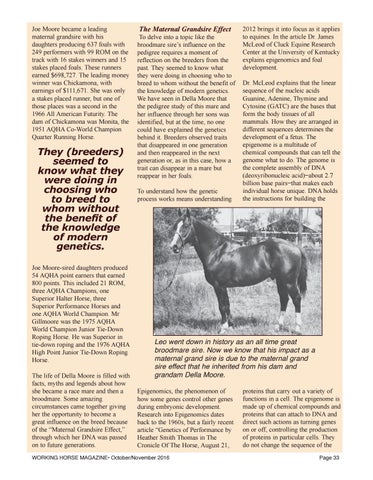Joe Moore became a leading maternal grandsire with his daughters producing 637 foals with 249 performers with 99 ROM on the track with 16 stakes winners and 15 stakes placed foals. These runners earned $698,727. The leading money winner was Chickamona, with earnings of $111,671. She was only a stakes placed runner, but one of those places was a second in the 1966 All American Futurity. The dam of Chickamona was Monita, the 1951 AQHA Co-World Champion Quarter Running Horse.
They (breeders) seemed to know what they were doing in choosing who to breed to whom without the benefit of the knowledge of modern genetics. Joe Moore-sired daughters produced 54 AQHA point earners that earned 800 points. This included 21 ROM, three AQHA Champions, one Superior Halter Horse, three Superior Performance Horses and one AQHA World Champion. Mr Gillmoore was the 1975 AQHA World Champion Junior Tie-Down Roping Horse. He was Superior in tie-down roping and the 1976 AQHA High Point Junior Tie-Down Roping Horse. The life of Della Moore is filled with facts, myths and legends about how she became a race mare and then a broodmare. Some amazing circumstances came together giving her the opportunity to become a great influence on the breed because of the “Maternal Grandsire Effect,” through which her DNA was passed on to future generations.
The Maternal Grandsire Effect
To delve into a topic like the broodmare sire’s influence on the pedigree requires a moment of reflection on the breeders from the past. They seemed to know what they were doing in choosing who to breed to whom without the benefit of the knowledge of modern genetics. We have seen in Della Moore that the pedigree study of this mare and her influence through her sons was identified, but at the time, no one could have explained the genetics behind it. Breeders observed traits that disappeared in one generation and then reappeared in the next generation or, as in this case, how a trait can disappear in a mare but reappear in her foals. To understand how the genetic process works means understanding
2012 brings it into focus as it applies to equines. In the article Dr. James McLeod of Cluck Equine Research Center at the University of Kentucky explains epigenomics and foal development. Dr. McLeod explains that the linear sequence of the nucleic acids Guanine, Adenine, Thymine and Cytosine (GATC) are the bases that form the body tissues of all mammals. How they are arranged in different sequences determines the development of a fetus. The epigenome is a multitude of chemical compounds that can tell the genome what to do. The genome is the complete assembly of DNA (deoxyribonucleic acid)−about 2.7 billion base pairs−that makes each individual horse unique. DNA holds the instructions for building the
Leo went down in history as an all time great broodmare sire. Now we know that his impact as a maternal grand sire is due to the maternal grand sire effect that he inherited from his dam and grandam Della Moore. Epigenomics, the phenomenon of how some genes control other genes during embryonic development. Research into Epigenomics dates back to the 1960s, but a fairly recent article “Genetics of Performance by Heather Smith Thomas in The Cronicle Of The Horse, August 21,
proteins that carry out a variety of functions in a cell. The epigenome is made up of chemical compounds and proteins that can attach to DNA and direct such actions as turning genes on or off, controlling the production of proteins in particular cells. They do not change the sequence of the
WORKING HORSE MAGAZINE• October/November 2016
Page 33
